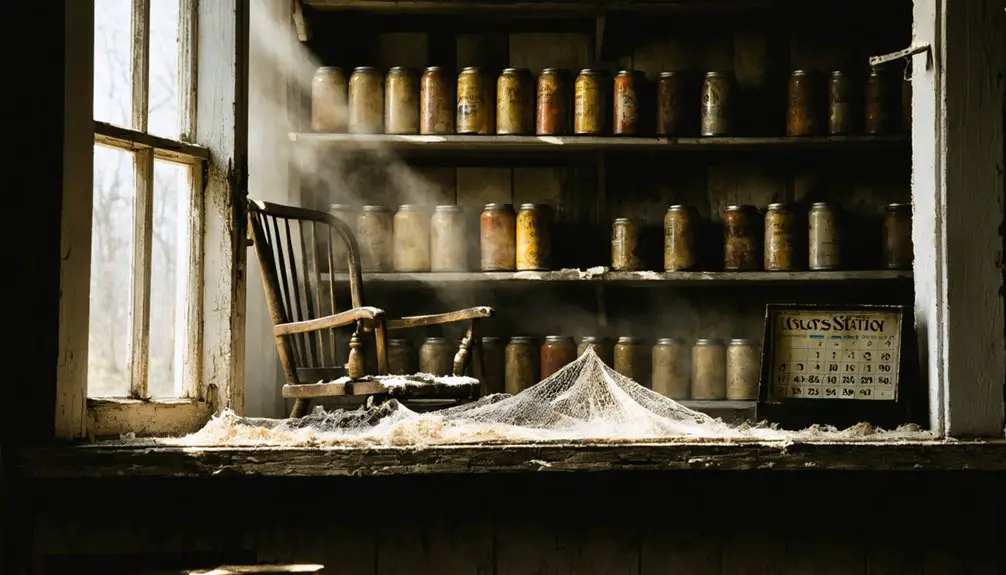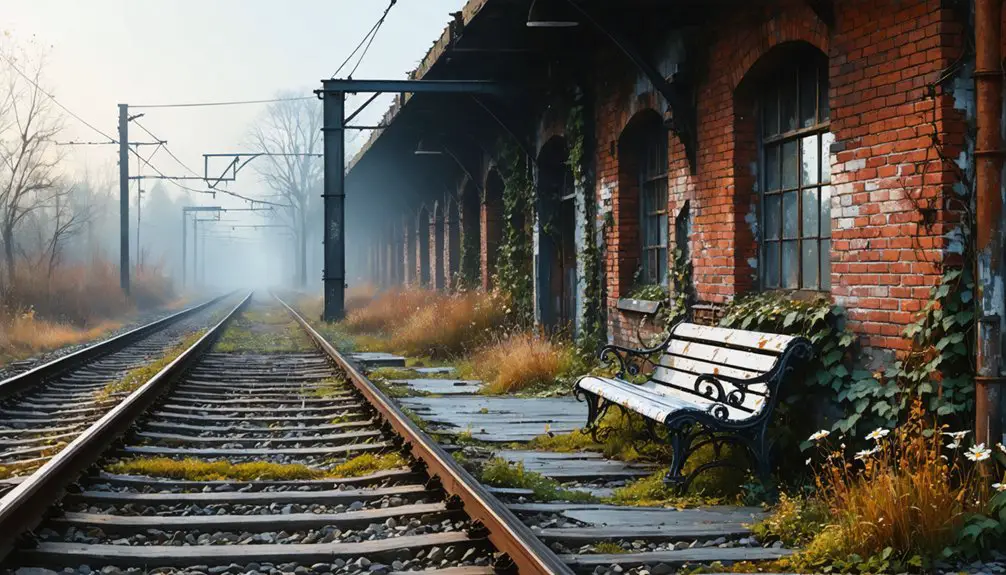You’ll find Kelly’s Station tucked away in Armstrong County, Pennsylvania, where it emerged as a crucial railroad junction in 1904. Named after Sheriff Hamilton Kelly, this once-thriving coal mining settlement produced 16 million tons annually during its 1910s-1920s peak. Irish immigrants and European miners filled company-owned houses, working dangerous mines until mid-century decline set in. While the Allegheny Valley Railroad’s 1984 closure marked its final chapter, the town’s ruins hold countless untold stories.
Key Takeaways
- Kelly’s Station transformed from a bustling coal mining town in 1904 to a ghost town following the closure of mines and railroad.
- The town’s decline accelerated after the Allegheny Valley Railroad ceased operations in 1984, severing vital transportation links.
- Population exodus occurred as young residents moved to urban areas, leaving behind abandoned company houses and shuttered businesses.
- Mining operations that once produced 16 million tons of coal annually completely ceased, devastating the local economy.
- The former railroad junction and mining community now stands largely deserted, with only remnants of its coal mining heritage visible.
The Rise of a Coal Mining Settlement
As the industrial revolution swept through western Pennsylvania in the early 1900s, Kelly’s Station emerged as a strategic coal mining settlement along the Allegheny River in Armstrong County’s Bethel Township. Established around 1904, the site’s historical significance stemmed from its prime location, which allowed coal companies to efficiently transport their valuable bituminous coal and coke products to market.
You’ll find that community development centered entirely around the mining operations, reflecting the era’s broader industrial expansion throughout Pennsylvania. The settlement took shape as coal companies built essential infrastructure, including coke works and transport systems. With production reaching 16 million tons annually during the 1910s and 1920s, Pennsylvania’s coal industry was at its peak during Kelly’s Station’s early years. Like many mining communities, workers faced dangerous working conditions that included long hours underground and constant risks of accidents.
Kelly’s Station exemplified how these company towns sprung up to meet the surging coal demand that powered America’s steel mills, railroads, and urban growth in the northeastern United States.
Life in Early Kelly’s Station
You’ll find that Kelly’s Station emerged as a crucial railroad junction in the early 1800s, where the main line intersected with smaller tracks serving nearby coal operations.
The station’s strategic position made it a natural gathering point for miners and railroad workers, who’d meet at the general store and boarding houses after their shifts. The Lake Shore railroad ran directly through the area, connecting it to other major townships. Dennis Kelly’s mills along the creek provided vital textile materials to support the local economy.
Beyond the coal dust and steam engines, you’d have witnessed a close-knit community forming around the station house, where families shared meals and stories while watching the daily parade of coal cars and passenger trains.
Railroad Hub Development
When the Allegheny Valley Railroad established Kelly’s Station in 1860, the small stop quickly evolved into a significant transportation hub named after Sheriff Hamilton Kelly, who served as both station agent and postmaster.
The station’s strategic placement along the AVRR line powered Pennsylvania’s industrial growth through railroad expansion and community development. The Pennsylvania Railroad’s massive network of 11,640 miles of track by 1926 helped facilitate this growth. After the first telephone lines were erected in Armstrong County, Kelly’s Station became connected to critical regional communications in 1863.
You’ll discover these key developments that transformed Kelly’s Station:
- Critical transport of iron ore, coal, and lumber connected rural suppliers to industrial markets
- Track improvements and steel bridge construction enhanced the station’s regional connectivity
- Integration into the Pennsylvania Railroad system by 1900 expanded service reach
- Construction of Brady Tunnel (1913-1916) streamlined routes by reducing sharp bends
The station’s role in freight and passenger services proved essential for the region’s economic significance and social integration.
Mining Community Social Life
Beyond the bustling railroad tracks, Kelly’s Station’s heart beat strongest in its mining community. You’d find Irish immigrant families living in company-owned houses, their lives deeply intertwined with the coal mines that dominated the landscape.
The town’s social fabric centered around religious institutions and mutual aid societies, where you’d witness remarkable community cohesion despite the harsh realities of mining life. Local entertainment included gathering at the State Theatre for moving pictures, providing a welcome escape from daily hardships.
Labor struggles shaped daily existence, as miners fought for better wages and safer conditions. The Panic of 1873 brought severe economic hardship, with many miners facing unemployment and destitution. While working grueling shifts underground or at the coal breakers, families depended on each other for support.
Children as young as seven worked alongside adults, earning meager wages separating slate from coal. The community’s spirit of resilience emerged through collective responses to mine disasters, with neighbors raising funds and providing aid to affected families.
The Railroad’s Impact on Growth
As the Allegheny Valley Railroad expanded in 1860, Kelly Station emerged as an essential transportation hub that would transform the region’s economic landscape.
You can trace the area’s rapid growth through railroad transportation and economic integration that connected this once-isolated community to thriving regional markets.
- Sheriff Hamilton Kelly’s role as station agent and postmaster helped establish the station as a crucial link between local residents and broader commercial networks.
- The railroad enabled efficient transport of iron ore, coal, lumber, and agricultural products.
- The first telephone lines in Armstrong County followed the rail corridor in 1863.
- Pennsylvania Railroad’s acquisition in 1900 brought major infrastructure investments, including steel bridges and the Brady Tunnel, enhancing the station’s connectivity to Buffalo, NY.
The station was named after Sheriff Kelly, who served the community for many years through his dual position as station agent and postmaster. The area’s rail services continued until economic challenges and an unsafe bridge over Kiski River forced operations to cease.
Mining Operations and Economic Peak
You’ll find evidence of Kelly’s Station’s coal mining legacy in the remnants of early mechanized equipment like steam-powered hoists and ventilation systems that supported underground extraction between 1890-1920.
The mining operations reached their zenith during this period, with coal companies employing hundreds of local workers who used pick axes, carbide lamps, and mule-drawn coal cars to extract thousands of tons annually.
Life for these miners centered around company-owned houses and the company store, where they’d purchase supplies and necessities using scrip payment from their dangerous work in the mines.
Mining Equipment and Techniques
While operating at its economic peak, Kelly’s Station utilized both room-and-pillar and longwall mining techniques to extract coal from the region’s seams. The mining operations showcased Pennsylvania’s most advanced coal extraction methods of the era, combining manual labor with mechanized systems for maximum efficiency.
You’ll find these key elements defined the town’s mining infrastructure:
- Continuous miners cut through coal faces in room-and-pillar sections, leaving support pillars to prevent collapse.
- Powerful longwall shearers moved along 820-foot panels, achieving over 90% coal recovery.
- Armored face conveyors transported freshly cut coal to the mine’s headgate.
- Hydraulic roof supports created protective “safety umbrellas” for miners working at the coal face.
These advanced mining techniques helped establish Kelly’s Station as a prominent coal-producing settlement in southwestern Pennsylvania.
Peak Production Years 1890-1920
Three decades marked Kelly’s Station’s most prosperous period from 1890-1920, when the town’s mining operations reached unprecedented levels of production and technological advancement.
You’d have witnessed the economic trends that transformed this small mining community, as wealthy outside investors from major cities poured capital into expanding operations. The town’s coal breakers hummed with activity, processing over 53,000 tons daily at peak capacity, while steam-powered engines and locomotives modernized mining operations.
Yet beneath this prosperity lay growing tensions, as labor movements emerged in response to dangerous working conditions.
Like many Pennsylvania mining towns, Kelly’s Station felt the impact of major mining accidents and worker unrest, while external corporate interests shaped its destiny through ownership consolidation and industrial expansion.
Local Mine Worker Life
Many immigrant miners from Southern and Eastern Europe formed the backbone of Kelly’s Station’s workforce during its economic peak, laboring in the extensive network of room-and-pillar mines that snaked beneath the township.
Through community struggles and immigrant experiences, these workers built a resilient mining culture centered around the local coal industry and coke works established in 1904.
Your ancestors’ daily mining life included:
- Working long hours underground in hazardous conditions, facing risks from explosions and toxic gases
- Living in company-built housing near the mines, fostering tight-knit immigrant communities
- Supporting families through dangerous but steady employment in both underground mining and coke production
- Contributing to the region’s massive coal output while adapting to life in a new country, often alongside fellow countrymen who shared their language and customs
Natural Disasters and Mining Accidents
As mining operations flourished in Kelly’s Station during the early 1900s, the town faced its share of industrial catastrophes and natural hazards that shaped its eventual decline.
You’ll find the most devastating event was the Smokeless Coal Company explosion of May 24, 1915, which claimed nine lives after a shot ignited gas and coal dust in the mine.
Like many Pennsylvania mining towns, Kelly’s Station struggled with disaster preparedness against multiple threats.
You’d see flooding in the valley during heavy rains, while mining hazards lurked underground in the form of structural instability and deadly gas buildups.
The earth itself posed dangers as mining operations undermined the ground’s stability, leading to subsidence that destroyed buildings above.
Regional statistics show over 3,000 mining accidents annually, with a third resulting in deaths from explosions, rock falls, and crushing incidents.
The Town’s Steady Decline

While Kelly Station thrived during Pennsylvania’s coal mining heyday, its downward spiral began in the mid-20th century when the coal and coke industries faltered. The town’s economic vulnerability became evident as it struggled to adapt to changing times, leading to a devastating cycle of decline.
Kelly Station’s promising coal town legacy crumbled as industry declined, leaving a community struggling to survive in Pennsylvania’s changing economic landscape.
You’ll find these key factors shaped Kelly Station’s fate:
- The closure of the Allegheny Valley Railroad in 1984 severed crucial transportation links.
- Young residents fled to urban areas, causing dramatic population shifts.
- Local businesses shuttered as the tax base eroded.
- Infrastructure deteriorated without funds for maintenance.
As nearby towns with better highway access flourished, Kelly Station couldn’t compete. The absence of economic diversification, coupled with the loss of fundamental services, transformed this once-bustling mining town into a shadow of its former self.
Remaining Structures and Landmarks
Despite decades of abandonment, Kelly Station’s ghostly remnants tell stories of its coal-mining past through scattered but significant structures.
You’ll find surviving community landmarks dotting the landscape, with Ukrainian Greek-Catholic churches standing as the most prominent remaining buildings. While most structures have been razed, concrete steps and sidewalks now lead to empty lots where homes and businesses once thrived.
As you explore, you’ll discover foundations and cellar holes marking vanished buildings, while old railroad tracks and buckled pavement trace transportation routes of the past.
Industrial relics like coke ovens and round bunkers remind you of the town’s mining heritage. Though nature steadily reclaims the land, these physical remnants preserve Kelly Station’s historical footprint, offering glimpses into its once-bustling community.
Stories From Former Residents

The physical remnants of Kelly Station tell only part of its story – the true heart of this ghost town lives on through the voices of its former residents.
Through personal memories and cherished tales, you’ll discover the deep community bonds that once defined this close-knit mining town.
- Former locals speak of multi-generational families who lived, worked, and celebrated together, creating unbreakable ties through shared experiences at local taverns and community gatherings.
- Parents recall watching their children grow up playing in streets now empty, attending schools that no longer exist.
- Mining families share stories of daily life underground, where fathers and sons worked side by side.
- Residents remember intense community debates about whether to stay or leave as environmental threats emerged, splitting longtime neighbors and friends.
Preservation Efforts and Historical Legacy
Since the allocation of $42 million in federal funds back in 1983, preservation efforts at Kelly Station have taken various forms – from structural conservation to cultural documentation.
You’ll find that despite significant challenges, including ground instability and toxic gases, several key structures maintain their historical significance. The Stone Church serves as a central gathering point for commemorative events, while preserved mining bunkers and cemeteries offer glimpses into the area’s industrial past.
Physical preservation faces ongoing obstacles due to the underground fire‘s destructive nature, yet you can still explore remaining foundations, sidewalks, and curbs that tell the story of this once-thriving community.
Through photographs, oral histories, and educational programs, Kelly Station’s legacy lives on as a powerful reminder of America’s mining heritage and environmental consequences.
Frequently Asked Questions
Are There Any Paranormal Activities Reported in Kelly’s Station’s Abandoned Buildings?
Despite 60+ years of abandonment, you’ll find no verified ghostly sightings in Kelly’s Station’s buildings. While steam rises eerily from ground cracks, the haunted history remains unconfirmed through official paranormal documentation.
What Artifacts Have Been Found by Archaeologists Exploring the Ghost Town?
You’ll find mining tools, coal chutes, railroad remnants, and household items like bed springs and mattresses. These artifacts provide significant historical context about daily life in this coal-mining community.
Did Any Famous Historical Figures Ever Visit Kelly’s Station?
Like finding a needle in a haystack, you won’t discover records of famous visitors to this spot, though Robert Morris and Stephen Girard owned nearby land, lending historical significance to the region.
How Does Kelly’s Station Compare to Nearby Ghost Town Centralia?
Unlike Centralia’s famous mine fire disaster, Kelly’s Station history faded quietly. You won’t find dramatic legends or mass evacuations here – just remnants of a railroad stop that time slowly forgot.
Are Metal Detecting or Artifact Collecting Activities Permitted in Kelly’s Station?
You’ll need proper approval before metal detecting here, as regulations protect artifact preservation. If it’s state land, get park manager permission; if private property, obtain written landowner consent.
References
- https://pabucketlist.com/the-rise-and-fall-of-centralia-pas-toxic-ghost-town/
- https://www.youtube.com/watch?v=Qj5LjacccJ0
- https://www.legendsofamerica.com/centralia-pennsylvania/
- https://www.cracked.com/personal-experiences-2537-i-live-in-centralia-pa-its-americas-creepiest-ghost-town.html
- https://www.youtube.com/watch?v=fm3wxSOqlYM
- https://www.heritagejohnstown.org/attractions/heritage-discovery-center/johnstown-history/history-coal-cambria-county/
- https://www.youtube.com/watch?v=P1ImKipDnTg
- https://www.pa.gov/agencies/dep/programs-and-services/mining/bureau-of-mining-programs/pa-mining-history.html
- http://coalmininghistorypa.org/annualreport/1931/1931_bit/1931_bit.htm
- http://coalandcoke.blogspot.com/2013/10/kelly-station-paprovident-mine-and-coke.html



